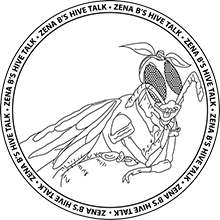Hive Talk - February 2021
Hive Talk February 2021

Hive Talk - February 2021
Happy ‘Lunar ‘New Year from Zena Bs!
As of February 14th, 2021, the bitter cold has consumed all living things to the point that having a -15 Deg C day would be balmy! And, bitter cold will kill a lot of virus-related illness, and it keeps people from travelling too far from home.
February seems to be a turning point to whether or not the hives survive the winter months. Without a moderate temperature break the bee ‘cluster’ doesn’t want to move around the brood boxes in search of their stored honey stash. Let’s hope that my population was big enough for their survival.
Today my hive monitor has registered 28.1 deg C. in the hive.
The hives are completely covered with the snow. Don’t worry there is a little open area for air exchange. The heat from the hives will create a tunnel to the outside world so that they can breathe.
And now to the topic of “heater bees”: ‘Heater’ bees play a very important role in the hive after the Queen starts laying her eggs in March. They dictate what role a young bee will take on after they hatch by the temperature the heater bees maintain in certain areas of the hive. For instance if an area of baby bees (pupae) are heated to a constant 34 deg. C they will develop into the forager bee, if temperatures are consistent to 35 degrees those pupae will develop into nurse bees, and so on. Approximately 20% of the bees take on the task to ‘heat’ the hive shivering the muscles of their thorax. The thorax is the segment of the bee that accommodates the wings, 3 sets of legs, one set of spiracles which aid in their respiration, as well as a complex set of muscles for locomotion. The ‘heater bees’ shake, or shiver, their flight muscles to the point where they are at least 10 degrees warmer than their sisters. They will strategically place themselves throughout the cluster to keep their queen, and brood warm, where it’s needed. A biologist used a thermal imaging device on an observation hive to witness this cool phenomenon. The regular brood and nurse bees showed up as a hot pink colour, and the heater bees were a pure white colour. A single ‘heater bee’ can warm up at least 70 brood bees. Statistically speaking there would be around 20% of these ‘hot’ girls in the hive!
I sure hope that the girls are working overtime keeping the cluster warm during this deadly cold. This weather will be a true test of my ‘Saskatchewan’ made bees.
